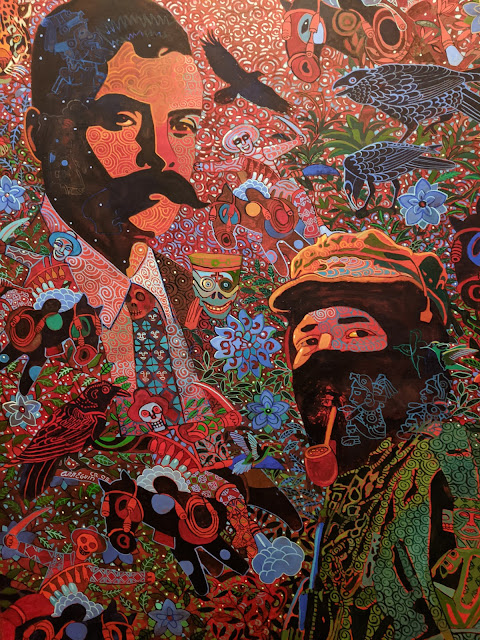Chicago has long been a place of cultural convergence. It is only fitting then, that during my recent trip there I explored some Hispanic aspects of the city. I experienced an array of art and vitality that altered my perception of Chicago and the heritage that defines it.
 |
| Heritage by Alfredo Arreguin |
Before the pandemic hit, which I think I will be saying a lot in the years to come, I had a chance to visit the Windy City with my girlfriend. It was a long, weekend-long trip, lasting approximately 3 days, including travel time. Our flight left Atlanta in the evening of February 27, well into the spread of covid-19 but two weeks before the White House declared a national emergency. We landed at night on a snow-dusted runway at Midway Airport, Ubered through the lit up city to our Airbnb in the Pilsen neighborhood, and discovered that our password for the Airbnb key container was incorrect. We spent a panicked few moments attempting to get the key out, worrying about what we were going to do at 1 a.m. in an unfamiliar city, when the Airbnb host came out, nearly as frightened as we were. She heard us fiddling with the lock and became alarmed, not realizing we were scheduled to arrive so late She promptly let us in, and so began our weekend-long jaunt in Chicago--one of the last out of town trips I’ll be making for quite a while.
The inside of the apartment was newly finished with hardwood floors throughout the main flat, new tiles in the bathroom, modern amenities and elegant furnishings. We took the master bedroom, although both bedrooms were quite large. My girlfriend’s friends arrived the next morning, settled in, and we promptly began to explore Pilsen.
First stop: the National Museum of Mexican Art (temporarily closed as I write this). Inside, some rooms were arranged to display the influences of Catholicism on the Aztec culture, which Spain dominated and decimated through colonization. These rooms displayed both Aztec art that came before the arrival of the Spanish and Catholicism, and the post-invasion blending of the two. Sculptures of Alebrijes, spirits that guide souls from our world to the afterlife, depicted in the movie Coco, adorned shelves protected by glass. Pottery from the ancient Aztec civilization was arranged next to them. Room upon room depicted a beautiful spectrum of Mexican art that, in degrees, slowly enlightened me on the rich cultural heritage and mediums that many artists in the Mexican past utilized (and still utilize in the present) to depict suffering, faith, despondency, resolve, persistence and a deep sense of cultural identity.
After our sojourn to the National Museum of Mexican Art, the trip wouldn’t have been complete without authentic Mexican food, and since nearly two-thirds of the Pilsen population is Hispanic, an authentic restaurant was not hard to find. In fact, in addition to a restaurant we found a Mexican bakery, butcher, tamales being sold on the side of street corners and a Mexican candy store. My choices here reveal my sweet tooth. We bought cupcakes and candy, and partook of both.
Back at the apartment, breaking with our recent Mexican theme, we watched, or rather, one of my girlfriend’s friends and I watched, a historical drama on Netflix called the Rise of the Ottoman Empire, which is part historical drama, part historical narrative on the triumph of the Ottomans over Constantinople in the 15th century. For the rest of the day we laid low, ate from the spoils we carried away from various Mexican establishments we had visited on the way back from the museum, and prepared for the Aventura concert we would attend later that night.
Who are Aventura? Besides being one of the most influential Latin music groups of all time? An American bachata group (a form of dance music originating in the Dominican Republic) that won mainstream acclaim with their 2002 hit "Obsesión.” Band members are Romeo Santos, Lenny Santos, Henry Santos and Max Agende Santos.
The concert was a spectacle. The event was special because the band hasn’t been together for 10 years, and this was their reunion tour, one of the main reasons we decided to fly to Chicago. I don’t speak Spanish, but my girlfriend does and it is safe to say she enjoyed the concert.
The next morning we met another group who had come up from Atlanta and we all toured downtown Chicago together. We took pictures in front of “Cloud Gate” by artist Anish Kapoor, better known as the bean sculpture. We went inside the cultural center and saw two exhibitions, including the Cuban printmaker Belkis Ayon’s prints, and an installment titled Chicago Artists and Immigration. Some themes here were similar to those we explored in the National Museum of Mexican art. Oppression, faith, rejection, resilience. Here, however, was a thicker, politically charged undercurrent applicable to the current climate in the United States.
We ended the evening at a cold Navy Pier, peering at the skyscrapers through the frigid, lake Michigan air. It was a bleak moment, made warm by the companionship of my girlfriend and our friends. The entire trip was the same, made significant by the people around me and our interest in the sights and sounds of an unfamiliar city, the historical implications on the past and present of the sights we saw and the potential historical significance that this moment holds for the future of all of us, the looming threat of a growing pandemic. We flew back the next day, back to familiarity and the impending lockdown.
I enjoyed this! A part of Chicago I haven't gotten to experience-yet.
ReplyDelete